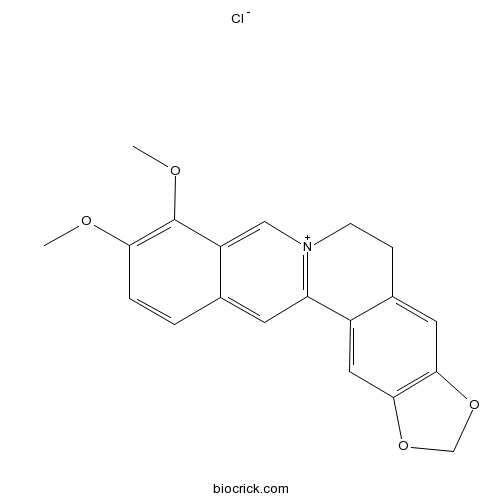Berberine hydrochloride (berberine), a natural plant alkaloid derived from Chinese herbal medicine, is characterized by diverse pharmacological effects, such as anticancer and lower elevated blood glucose, it can prevent adhesion by downregulating ICAM-1 and reduce inflammation by inhibiting the TAK1/JNK and TAK1/NF-κB signaling after abdominal surgery, which brings out a good therapeutic approach for the development of clinical application for postoperative abdominal adhesion and inflammation.[1]
Berberine hydrochloride is a conventional component in Chinese medicine, and is characterized by a diversity of pharmacological effects, has anticancer activity and
the chance of regulating glucose and lipid metabolism in cancer cells showing more potential than ever. [2]
Berberine hydrochloride is an alkaloid with little or no fluorescence in water,in sodium dodecylsulfate solutions, the fluorescence intensity of this compound is enhanced several folds by ion-pairing with the anion of the surfactant. [3]
Berberine hydrochloride can significantly attenuate neutrophil infiltration, suppress myeloperoxidase activity, decrease NO, TNF-αand IL-1βproduction, inhibits the phosphorylation of the NF-κB p65 subunit and the degradation of its inhibitor, IκBα, thus, exerts potent anti-inflammatory effects on LPS-induced mouse endometritis and may be a potential therapeutic agent for endometritis.[4]
Berberine hydrochloride has significant reductive ability and radicals scavenging effects, especially on ABTS, hydroxyl radicals and DPPH radicals.[5]
Sensory evaluation of the taste of berberine hydrochloride could be used an Electronic Tongue.[6]
Berberine hydrochloride has antifungi activity.[7]
English website: Berberine hydrochloride
Japanese website: Berberine hydrochloride
Chinese website: Berberine hydrochloride
[1] Zhang Y, Li X, Zhang Q, et al. J Pharmacol Exp Ther, 2014, 349(3):417-26.
[2] Wen T, Li Y, Chen M, et al. Int J Nanomed, 2011, 6(default):1773-7.
[3] Iwunze M O. Monatshefte Fuer Chemie/chemical Monthly, 2000, 131(5):429-35.
[4] Fu K, Lv X, Li W, et al. Int Immunopharmacol, 2014, 24(1):128-32.
[5] Luo A, Fan Y, Luo A, et al. J Med Plant Res, 2011, 5(16):3702-7.
[6] Wang Y, Feng Y, Wu Y, et al. Fitoterapia, 2013, 86(4):137-43.
[7] Nakamoto K, Sadamori S, Hamada T. J Prosthet Dent, 1990, 64(6):691-4.
[8] Xiang L I, Liu G Y, Jian-Li M A, et al. Pharmaceutical Journal of Chinese Peoples Liberation Army, 2013(05):458-60.



